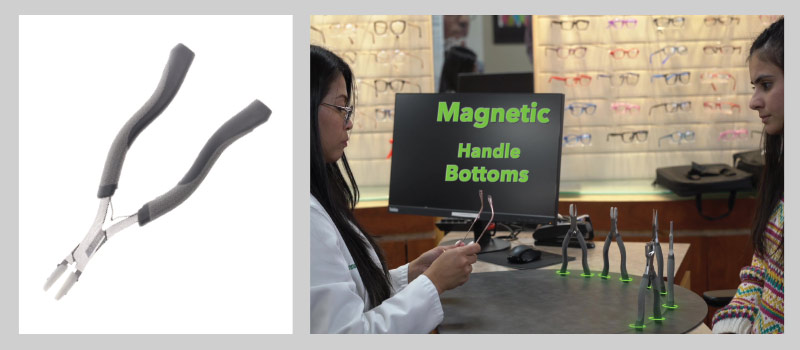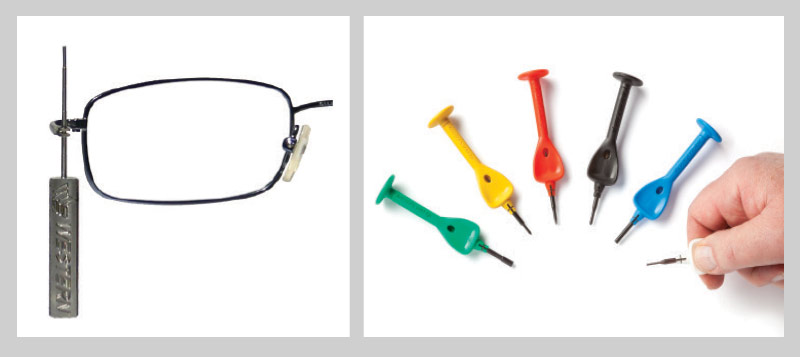By John Seegers

Every optical shop or retail store has its share of walk-ins. Sometimes it’s a familiar customer who wants us to repair or adjust their frame, something many opticians won’t charge a fee for. Yet often it’s a stranger who is requesting a free service. What do you do?
Many opticians are inclined to deal only with paying customers. We overlook the opportunity presented to us when someone comes in with a request for a no-charge repair or adjustment. Perhaps we do this because it is human nature to discount the stranger or the unfamiliar face asking us to do something for nothing.
I’m not suggesting that you should do every frame repair for free. However, I’ve learned that every time an individual enters your store or practice, they give you an opportunity to shine. Perhaps the best time to shine is when we are dealing with a stranger. When someone asks you to repair their frame, whether it’s as simple as replacing a missing screw or as complex as refurbishing a vintage frame, you can truly win hearts and minds.
A FREE SET OF NOSEPADS CAN TURN INTO A $1,000 SALE
Most areas of the U.S. are experiencing tremendous growth. Chances are excellent that new homes, apartments and senior living facilities are being built within 10 miles of your store or practice. You probably have a steady stream of new potential customers stopping in and asking you for repairs or adjustments. If you take the time and knock that repair out of the park, you may very well have a new customer and even better, a new customer for life.
What does “knocking it out of the park” look like?
First: If you can, take the time to make that repair while they wait. A full-service tune-up should take the seasoned optician about 10 minutes to complete. This is particularly useful to you, since your customer will wander the store and look at what you have to offer while you work. This new customer will listen to some customer interactions and perhaps speak with other staff. Maybe with a little encouragement, they’ll wander over to the frame boards and try some things on. So whenever you can, take care of those “can you do it now” requests immediately.
Of course, there is a flip side to this. When you are already fully engaged with a paying customer, you may need to say, “I’ll be happy to do that, but I (we) do have a few jobs ahead of you. I (we) should be able to have those ready right after lunch. Can you leave the glasses and your name and number, and I’ll (we’ll) have them ready for you then?”
Second: Since you are working on a pair of glasses, always replace pairs of nosepads or temple ends. This is a pet peeve of mine. Within reason, don’t balk at replacing the second one, no matter its condition. If you replace the left nosepad, replace the right one too. Same for temple ends.
Third, and this is the key: Don’t just do the repair or adjustment your customer asked for. Under promise and over deliver. Go over that complete pair of glasses. As a seasoned optician, this process should be second nature. Your hands should be in muscle memory mode, running through your frame tune-up. For my newbies, this will come in time. The more you do it, the easier and more automatic it becomes. If you struggle with doing these tune-ups quickly, then grab 20 old frames, take them apart, and put them back together again. Have a co-worker bend them up and have you straighten them out again. Work on that skill set.
As you mentally and physically work your way around that frame:
- Check ALL the screws for tightness. Hinges, eyewires, nosepads, ALL of them. If one screw has been replaced before, and it is the wrong length or color, then replace it with the correct one.
- Check the nosepads and replace them if they are worn or torn. Even if they are just starting to show signs of wear, a fresh set of silicone pads will feel better to the wearer. Adjust the guard arms if necessary.
- Make sure both lenses are properly seated within the eyewire.
- Replace any worn temple ends.
- Return them to good standard alignment.
- Clean the glasses well before returning them to your customer. If necessary give them a warm water bath with soap and a toothbrush.
If they gave them to you in a case, and their case is a mess, give them a new one. In short, hand them back a pair of glasses better than the ones they had before the need of a repair. That is what “knocking it out of the park” looks like.
Now, here is the important part after all your time and hard work: Tell them what you did. Pat yourself on the back. Brag a little!
What you actually say to that person when handing back their glasses: “I replaced that missing nosepad. I went ahead and did both of them so that should feel much better. I replaced that odd screw on the left side. I slid on a few new temple ends for you and bent them back in shape. Why don’t you try them on and see if they feel a lot better now?” Chances are excellent that they will.
What you are really conveying is “I went above and beyond what you asked me to do. I’m a competent optician proud of the work I do. Here at XYZ Optical we take pride in doing a job right. This is the same level of service you can expect if you come back here the next time you need glasses.”
I know stores have different policies. It is my very firm belief that when you are asked, “What do I owe you,” the correct answer is, “Oh, nothing, happy to do it for you. Hopefully we will see you again.”
It might help to think about this as interpreting the 1-10-100 rule backwards. If you satisfy that one customer, they will most likely tell 10 others about that experience, and those 10 will tell five others. One satisfied new customer can create 61 potential new ones. This is particularly important when dealing with the residents at that new 55-plus retirement community they just built down the road.
A FREE SET OF NOSEPADS CAN TURN INTO THOUSANDS OF DOLLARS IN SALES OVER TIME
Of course, you also need to use your business/optician “spidey” sense. Given time, you should be able to pick up on when you are being taken advantage of. When Mr. Jones brings in a bag of 20 20-year-old glasses, asking for them all to be tuned up for nothing, then it is time to charge appropriately for your time, skill set and materials.
Having covered the philosophy of repairs and adjustments, let us move on to the physical side of things. I like to think of repairs as being offered on a sliding scale or continuum.
At the bare minimum, any shop or practice (and I mean any) should:
- Stock a few and be able to replace common size screws for eyewires.
- Stock a few and be able to replace common nosepads.
- Stock a few and be able to replace temple ends.
On the far other end of the continuum, you might have a full-service repair shop (such as Northwest Frame Repair) where they can fix just about anything and even do complete vintage refurbishing. For most shops or practices, you will fall somewhere in between. In my opinion, any optical shop should:
- Stock a wide range of and be able to replace screws for almost all eyewires, temples and nosepads.
- These should include many different sizes/diameters, lengths and colors, and include your tap-n-snap variety and coated varieties as well.
- Stock a wide range of nosepads and be able to replace them.
- These should include hard nosepads, soft nosepades, L/R, buttons, screw-on, push on, 9 mm to 19 mm, etc.
- Stock a wide range of temple ends and be able to replace them.
- These should include different colors in solids, different colors in tortoise and different inner diameters for different temple sizes.
Of course, every shop or practice needs a full set of quality and properly maintained tools. Although they are popular and a quick way of “getting all you need,” I’ve never suggested kits, but rather encourage you to build your own toolbox and parts center over time.
Any competent optician should also be able to:
- Remove and replace a broken screw.
- Re-string a semi-rimless frame (including plastic ones).
- Resize a lens and do an emergency frame swap.
- Perform temporary fixes using epoxy (hinges and broken plastic eyewires).
- Repair and reload figure-eight liner.
- Lengthen or shorten common metal temples.
- Break down and rebuild a bushing style three-piece mount.
As an optician, you’ll have the skill set to perform a wide range of repairs and adjustments. This should be a source of tremendous pride for you. Looking at what you have just done and knowing in your heart that not just anyone could do it should make you feel great.
Anyone calling themselves an optician, wearing an optician name badge or who has a license or certificate on the wall must be able to perform all the repairs outlined above. Those repairs are the very foundation of optician competence and a key part to the very meaning of the role.
Some shops may offer advanced repairs including soldering or have a soldering service; breaking down and rebuilding screw mount three-piece mounts; acetate repairs and polishing.
If your store or practice already provides this level of customer service and repairs, that is fantastic. If you don’t, it may be time to re-evaluate how you are thinking about it. I know from years of hands-on experience that a free set of nosepads can lead to a $1,000 sale and thousands of dollars in sales over time.
A SINGLE VISION SOLUTION
Although this is not technically a repair, if your shop has an edger, any optician should also be able to run a basic single vision job for a customer while the customer waits. No customer should ever have to do without glasses for more than a 24-hour period, period. You may send them away with a single vision distance pair of glasses instead of a fancy freeform progressive, but they should be able to drive while their freeform progressive is being run.
–JS
USING THE RIGHT TOOL FOR THE RIGHT JOB
No matter whether frame repairs and adjustments make up a large or small portion of your daily work, dispensers and technicians must be ready for any situation that a customer presents. That requires them to maintain a full set of tools and spare parts. Fortunately, there’s a wide assortment of purpose-built products to choose from, and suppliers are continually expanding their lines with cleverly designed tools that make the optical techs’ or dispensers’ job easier than ever. Here’s a look at six innovative new products by three of the top suppliers of optical tools and equipment.
–Andrew Karp

HILCO VISION
The ErgoProfile Surface organizes your tools and provides a durable work area. It comes in two high-grade performance materials, faux leather and fabric, as well as two sizes: work bench and dispensing station. A magnetic surface keeps screws and other small parts from getting lost and lets you stand tools up for convenient access. An organizing guide rail on the work bench model helps keep tools and parts within easy reach. A counter edge with a 1-inch lip to prevent tools from falling off and a non-skid protective bottom keeps everything secure.
The ErgoPro Double Nylon Plier is a multipurpose tool for delicate frame adjustments: bridge, endpiece and temple. It features a slim jaw design that provides unmatched control and precision, while the protective pads ensure that delicate finishes remain unscathed.

SIOS
Sios Lab Modular System Tool Kits offer a new way to organize your workspace and increase productivity. The color-coded systems are engineered to simplify and expedite the process to complete jobs quickly, according to Sios.
One of Sios’ most popular tools is the Nose Pad Assembling Plier. With both tips perfectly designed for closing the two pins of the RB nose pad, it ensures secure installation. Sios’ tools are created by using a special integrated spring; this tool offers greater precision, speed and maximum comfort compared to traditional models.

WESTERN OPTICAL SUPPLY
The Goldilocks Screw Gauge is a precision milled steel probe graduated in six “steps” of increasing diameter. Insert the gauge through the barrel’s bottom threaded leaf until it feels snug. Note which “step” is in the barrel. Compare that “step” to the sizing chart provided to determine the proper replacement screw diameter. The colors on the chart correspond with most major screw suppliers’ color code on the cap of the screw vial.
EZGrip Drivers provide an elegant solution for those who have a difficult time holding on to a standard screwdriver and having to give it super-duper torque. Use when you have a stubborn screw to break free or tighten down the final threads. Ergonomically contoured scoop cradles your thumb and opposing pointer finger for a seriously comfortable grip. EZGrip Drivers are designed for maximum comfort, whether you have arthritis, large fingers, small fingers, sensitive fingers or a weak grip.
John Seegers is director of education for the independent wholesale lab Laramy-K and creator of the opticianworks.com optician training program.












